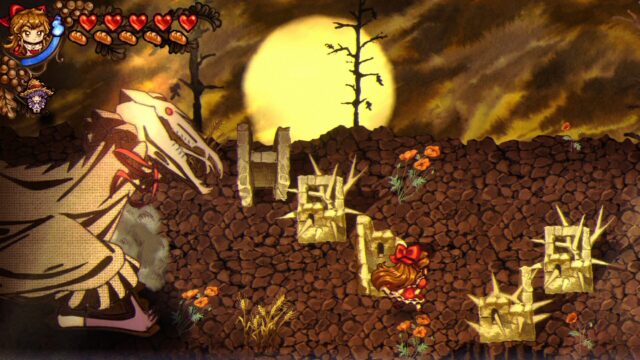Little Goody Two Shoes Deep Look
There are many tantalising threads that dangle, and the promise of a large number of endings should encourage those who can get past its challenging puzzle phases to dive deeper and uncover all the possibilities.
AstralShift’s Little Goody Two Shoes is a fairly fascinating adventure. There’s plenty to draw in players with its combination of dark fairy tale horror, time management, dating sim elements, and 90s anime visual inspiration. But while the game’s style and underlying mysteries have much to recommend it, frustrations surrounding its puzzle and action elements will turn off some players.
The game begins with a montage showing Holle coming across a seemingly abandoned baby girl in the woods and raising the girl as her own granddaughter before she passing away. In the present day, the girl, Elise, still lives in their house on the outskirts of the village of Kieferberg making a living doing odd jobs for the villagers. Elise longs to be free of her meager, unsatisfactory existence and dreams of obtaining wealth, glory, and a life of leisure. After an unexpected visit from a girl named Rozenmarine, Elise finds a pair of red shoes buried in her garden, while all around the village mysterious happenings start to occur. Soon after, Elise learns of a supposed powerful being living in the forest who can grant wishes in exchange for an appropriate offering.
Little Goody Two Shoes divides each in-game day into six segments. During the day, players can spend their time wandering the village, advancing the story, earning money through odd-job mini-games, or going on dates with the three female love interests. There is balance required here; do players focus on building relationships, which could be key for the story, or do they earn much-needed money to ensure they have sufficient food and healing items for survival? As the game progresses, players will also need to manage the town’s suspicion of Elise. The strange goings-on invite accusations of witchery, and Elise’s responses to conversations with villagers — as well as other actions or inactions — can cause the town’s suspicion to rise or fall.
One night falls, the sixth and final period of the day — the witching hour — begins. Elise and players are most tested here as she must venture into the forest and deal with many hazards and creatures to discover the secrets that lie within. Elise has no way of fighting back, so it’s usually a matter of finding the correct paths of actions to take while avoiding danger. The game provides some visual clues to many of these, but they are very subtle, so it often comes down to trial and error. Players will see the game over screen many times before progressing when enemies suddenly pop out or overwhelm Elise. While save points are delivered frequently enough that players won’t have to repeat too much, it is frustrating to replay the same conversations while trying to figure out what needs to be done to advance. The hostility and high level of danger is understandable from a thematic perspective, but it arguably goes too far and the annoyances at trying to progress drown out the creeping horror of the story. Even though players also need to keep on top of Elise’s hunger and sanity, the unforgiving nature of the puzzle and action sections act as the biggest barrier to progress.

While the rest of the game is quite laid back, the witching hour necessitates annoyingly precise actions while trying to spot overly subtle hints.
Elise is an interesting lead character. While she is brash, sometimes insulting, and has selfish desires, she is determined, won’t abandon those in trouble, and shows kindness when push comes to shove. Her potential love interests have multiple sides to them as well, and though the townsfolk are little more likely to fall into some stereotypical behaviours, it works within the story and medieval rural setting. The game does a great job of introducing its many mysteries and keeping players curious as to what exactly is going on and unsure of who or what they can trust, even if the horror is a little reliant on jump scares. There are many tantalising dangling threads, and a decent number of potential endings should encourage those who can get past its challenging puzzle phases to dive deeper and uncover all the possibilities.
Little Goody Two Shoes’ visual style nicely accompanies its curious blend of mechanics, and its use of effects and filters to emulate its inspirations is a treat. The game is surprisingly intricate, from the detailed backgrounds and location design to the old-school arcade game style of Elise’s various jobs. There is a good dichotomy between the welcoming rural daytime and the disturbing hostility of the witching hour that builds on its horror themes, and it’s appreciable that the game doesn’t rely on gruesomeness to convey its dread and horror. The music is strong, with catchy tunes during the daytime and appropriately haunting tracks at night, but the voice acting is a set of generic cries that, while punctuating Elise’s character, quickly become repetitive.
Little Goody Two Shoes certainly has a lot going for it. Many players will be enraptured by the game’s style and will desire to get the bottom of its mysteries, as well as enjoy the risk versus reward element driven by Elise’s desires. If the game was more welcoming of players who can’t quite grasp its subtle puzzles and the precise reactions needed to get past certain sections, it would be an unqualified recommendation, but at present that does make for a significant caveat.
Disclosure: This article is based on a copy of the game provided by the publisher.







Recent Comments